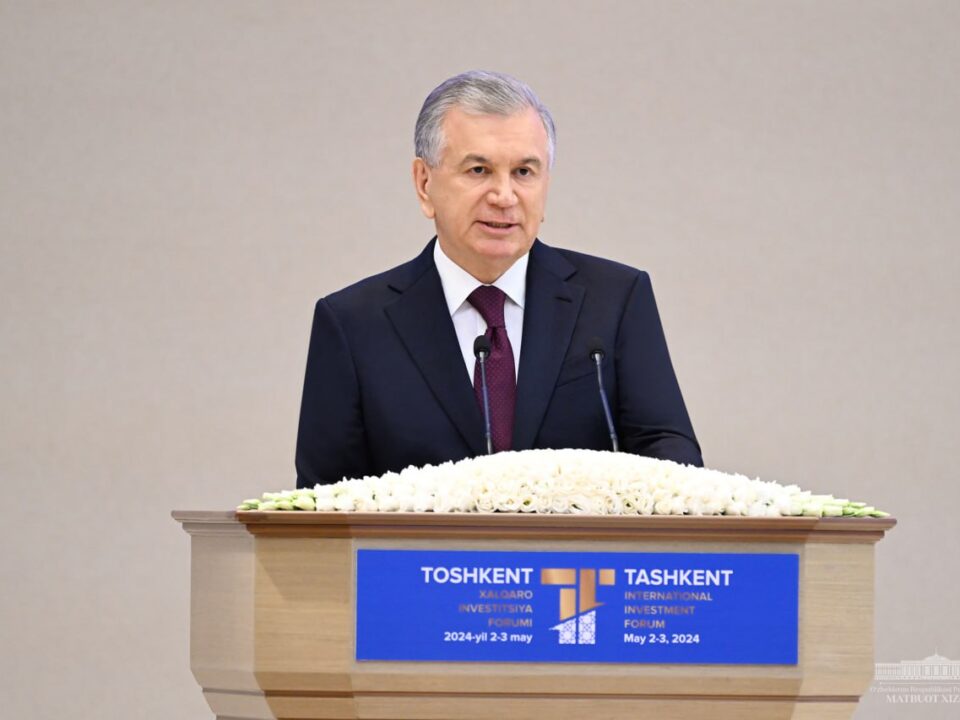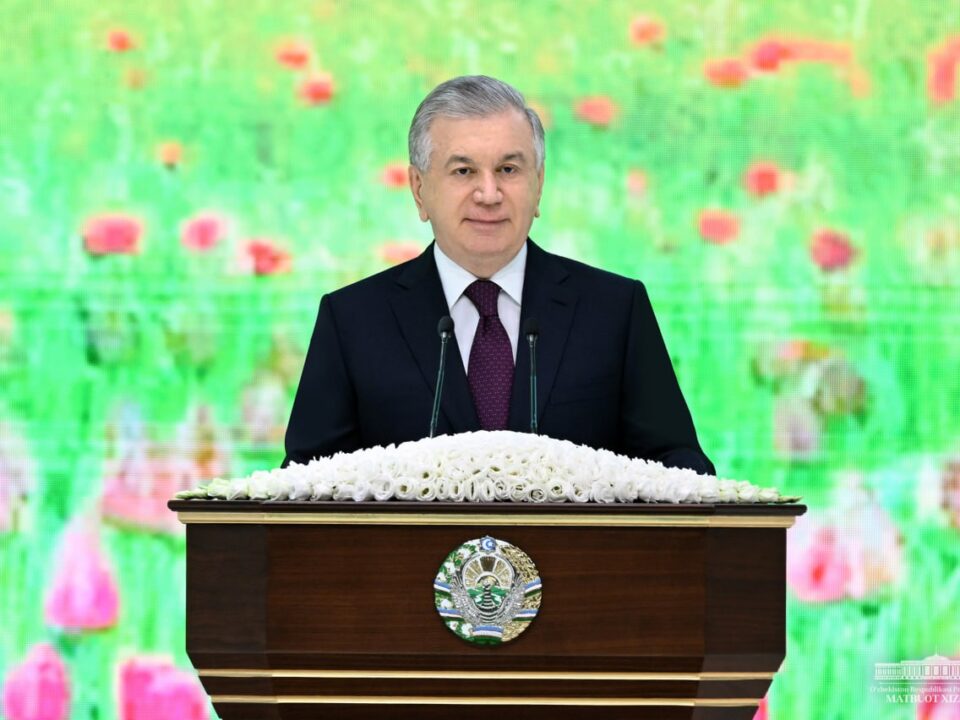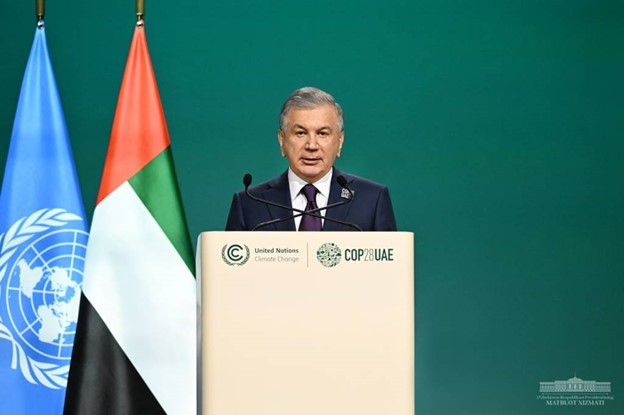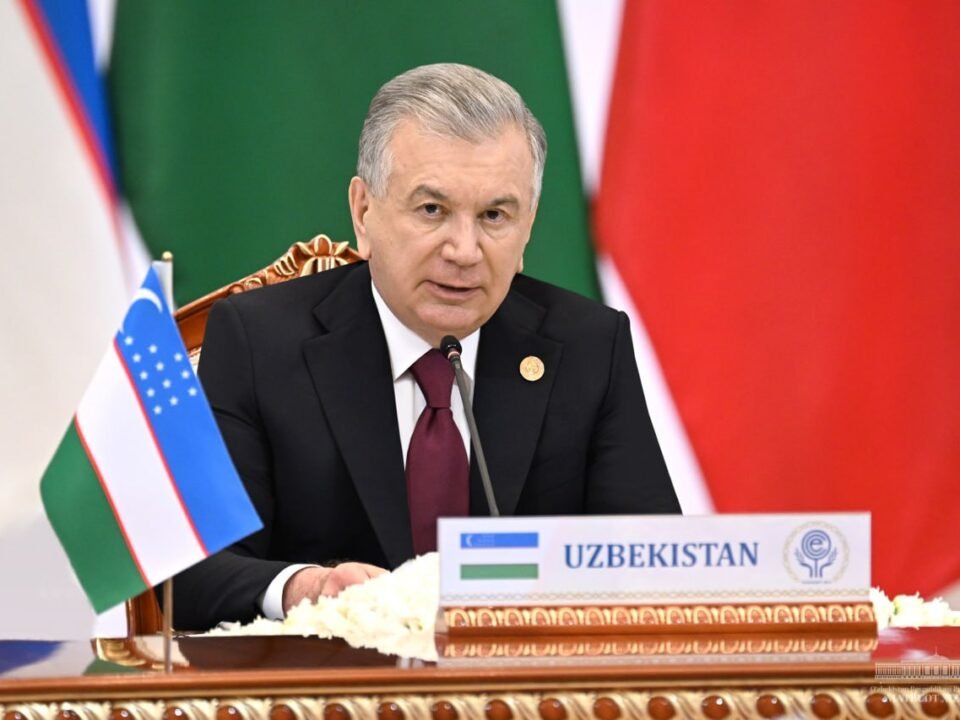Esteemed participants of the Forum!
Ladies and gentlemen!
It is a tremendous honor for us to welcome you, our dear guests here in Tashkent, the heads of prominent international organizations and financial institutions, governments, major agencies and companies, research centers, specialists and experts – participants of the current meeting of the Forum, and express our sincerest respect for every one of you.
My words of gratitude go to President of the Asian Development Bank Takehiko Nakao for his personal participation in the Forum, his enormous contribution to the implementation of the Asian Initiative in Solar Energy, for the invaluable assistance and support being provided by the Asian Bank and its structural institutions for the use and the encouragement in the accelerated development of solar power.
I would like to earnestly thank for the attendance of the meeting the representatives of the International Energy Agency (IEA), the United Nations Industrial Development Organization (UNIDO), the Islamic Development Bank and other international centers and institutions – and all who have displayed big interest in this Forum.
Indisputable as it is, the comprehensive discussion within the proposed agenda of this meeting, namely, the “Trends and Prospects of Solar Energy Technologies”, is rather urgent, and for the most part such topic as the development of industry for manufacturing the equipment and components and the growth prospects of the Asian market in solar energy equipment, carries a practical appeal to many countries and regions.
Throughout the history of human civilization, the search for the most efficient sources of energy is known to have been in the heart of attention. Massive investments have for the last decades been and continue to be assigned to primarily the development of hydrocarbons as major crude for the production of electric and thermal energy.
It is hardly a secret to anyone that possessing the sources of energy resources, oil and gas reserves is currently one of the most critical factors in generating immeasurable revenues and wielding influence at the international arena.
I believe one should not doubt also the fact that the so-called “shale revolution” in the extraction of crude hydrocarbons can tomorrow become a serious factor in the transformation of the standing and role of certain continents, countries and other territorial units in the energy market and the geopolitical alignment of forces in the global arena.
However, this sort of transformation can by no means change the interest and need mounting with every coming year in the renewable sources of energy and, first and foremost, in the use of solar power, the cleanest one in our world.
Expounding on this, one can in no way ignore the fact that, as the International Energy Agency data suggest, the solar power industry – the most promising constituent of renewable energy sources – has been expanding for the last five years with unprecedented annual growth rates of 60 percent amid the average growth rate in the production of electric power around the world at 3.4 percent.
The sum total of investments into the solar energy industry within the last five years has amounted to 520 billion dollars, including 143 billion dollars in the year 2012 alone.
The aggregate production of power by solar plants in 2012 equaled 113 billion kilowatt hours, including 110 billion kilowatt hours generated by photoelectric stations.
According to international specialists, there are enough reasons that precondition such a speedy growth in the interest in searching and raising the efficiency of alternative and renewable energy sources across the globe, notably in the use of energy emitted from the sun for the production of electric and thermal power.
These are primarily the world economy’s annually mounting needs in energy. In addition, the international community’s concerns focus, along with the growing intricacies in the development of new sources of conventional hydrocarbons, that is, oil and gas, on the rapid exhaustion of their reserves.
Yet the most crucial aspect that we barely have the right to disregard is that the use and combustion that has reached colossal volumes of fossil fuel has been inflicting a notable damage to the environment and affecting the health and quality of life of the population, threatening thus the sustainability of future development at the global level.
The way out from the unfolding situation is seen, first, in bolstering the flow of investments into projects designed to boost solar power industry as the most effective and promising source of renewable types of energy.
Second, what is needed is the wide-ranging intensification and government support for scientific and experimental-design innovations as well as encouragement of producers and consumers of solar power.
Third, it is essential to secure competitiveness for solar energy industry vis-à-vis the conventional one that is based on the use of hydrocarbons.
Without any doubt, this goal becomes more feasible if we take into account that the production of one kilowatt hour of solar electric power used to cost 35 cents back in 2008, while today it costs, according to experts, 11-12 cents on average. Yet in some nations like China and India, the prime cost of one kilowatt hour is projected to be reduced down to 8-9 cents at the photoelectric stations being built there.
Put another way, the electric power generated by photoelectric devices in some countries, even lacking traditional privileges and preferences, is capable of competing with energy produced by the combustion of hydrocarbons.
Moreover, there is certain logic in the deliberations of some academics when, analyzing the cycles of recurrent global economic crises, they come to believe that the search for ways out of the destructive downturn leads the world community – quite naturally – to grasp technologies of fundamentally new generation. In other words, they guide to new phases of scientific and technological progress that provides for more dynamic and efficient rates of production growth.
In this regard, one can easily come to conclude that the exit from the ongoing global slowdown that started in 2008 is largely contingent on how sooner we will be able to pass on to the new stage of technological breakthrough, primarily in the energy sector.
The discourse also concerns the fact that today, the unreasonably high prices for traditional energy resources, for oil by and large, are one of the principal obstacles for the rehabilitation of economies in the developing countries. The mass introduction of economically efficient sources of photoelectric energy will allow for sustaining the prices for oil in the future within sensible limits that will prove an encouraging factor for an accelerated growth in the developing countries, who currently are forced to spend their limited currency resources on the imports of crude hydrocarbons. To this end, the solar energy can and must become one of the locomotives in the way out of the crisis.
Dear Forum participants!
Let me briefly speak about the efforts being undertaken in Uzbekistan in the use of power emitted from the sun in energy purposes, and also about the factors conditioning the necessity of expanding the scales and practical designation of these processes.
This is dictated for the most part by the steady high rates of development as well as cardinal structural reforms, diversification and modernization of the economy, the advanced growth in the manufacturing industry, the potent modern gas-chemical complex shaping in the country and outfitted with the latest technologies in the deep reprocessing of hydrocarbon and other raw resources.
Suffice it to say that notwithstanding the negative impact of the global financial and economic crisis, the gross domestic product in Uzbekistan has been growing at annual rates of more than 8 percent for the last six years.
Within the 2000-2013 period it has multiplied 3.8 times, while the per capita gross domestic product has increased 3.2 times.
According to assessments of international financial institutions, the Uzbek economy is going to keep with such high growth rates in the foreseeable future.
As the evaluations suggest, the country’s needs in the electric energy will increase in the year 2030 approximately twofold compared to this year’s indicators and will exceed 105 billion kilowatt hours, taking into account the high advancing development rates in the manufacturing industry.
As far as the potential and prospects of solar energy industry in Uzbekistan are concerned, I would like to stress the following.
First and foremost, in geographical location and climatic conditions Uzbekistan enjoys an exclusively favorable environment for this to be achieved.
In the number of sunny days in the year, which amounts to more than 320 days, our country is ahead of many regions of the world.
As the Asian and World Bank assessments indicate, the gross potential of solar power in Uzbekistan exceeds 51 billion tons in oil equivalent.
These resources, experts suggest, allow for the production of electric power 40 times as much as the annual consumption of power in our country this year.
The research in the use of solar energy was afforded a huge impetus in Uzbekistan in the 1980s, when the scientific-experimental center “Physics-Sun” (Scientific-Production Association) of the Academy of Sciences was built. The institution was unique to Asia and its innovations have enjoyed renown far beyond the borders of our nation.
The current forum’s participants have been granted opportunity to familiarize with that center, for it is part of the forum itinerary, as far as I know.
The scientific complex comprises a huge solar furnace with a 1 megawatt-capacity helio-concentrator, allowing it to reach nearly 3 thousand degrees of temperature and provide for the production of super-clean materials. In addition, it facilitates the conduct of unique scientific research and thermal tests.
Today, Uzbekistan wields a considerable potential of scientific and technical specialists, experiment cadres, and a remarkable volume of design-engineering and technological innovations in designing and using the solar power.
The International Institute of Solar Energy has been established in Tashkent this year at the “Physics-Sun” Scientific-Production Association in partnership with the Asian Development Bank. The institution is expected to become a regional center for the conduct of scientific and experimental research, the outcomes of which can be cashed in as promising technologies in the use of solar power.
In cooperation with the ADB, we have embarked on a pilot project for the construction of a solar photoelectric station with a capacity of 100 megawatt in Samarkand region. For a relatively short span of time, a design-technical documentation has been prepared, a land of more than 400 hectares has been allocated, and all practical issues related to the launch of construction works at the facility have been tackled.
In the forthcoming period, we intend to launch construction of some other major solar power plants based on novel highly efficient technologies. To meet these ends, we have deployed state-of-the-art measurement stations in 6 regions of Uzbekistan in cooperation with the ADB, and hence we have been collecting all data essential for the development of thorough projects.
I would like to mention in particular that Uzbekistan possesses the richest reserves in raw materials for the production of photoelectric modules and other equipment for solar energy industry.
Last year, jointly with South Korea-based Neoplant, we launched the operation of a factory to produce technical silicon, with a capacity of 12 thousand tons a year. The second such silicon production plant with a capacity of 5 thousand tons per year is being completed in construction currently at the Angren Special Industrial Zone with the participation of the South Korean Shindong Enercom. This product can potentially become a source of crude for the production of highly efficient photoelectric solar panels.
We are going to launch production of photoelectric panels with an initial capacity of 50 megawatt in the Navoi Free Industrial and Economic Zone in 2014 with the participation of major Chinese companies. An enterprise to manufacture solar thermal collectors with an annual capacity of 50 thousand units is to be built at the Jizzakh Special Industrial Zone.
Tremendous significance is being attached to the extensive introduction of solar power in the household and community housing conditions as well as private house ownership, and to the creation of production and servicing capacities necessary for these purposes.
In our evaluations, the full-scale realization of these technologies will allow for the reduction of load on the power system by 2 billion kilowatt hours in the next few years and secure a local production of thermal energy in around 2 million Gcal, which will in aggregate help to save power resources in the equivalent of more than 250 million dollars every year.
Let me draw your attention to the fact that as part of the program of housing construction in rural areas run jointly with the Asian Development Bank, we have been erecting in excess of 10 thousand modern standard-design individual homes with a total of more than 1.5 million square meters of space.
Within the abovementioned program, we envision to launch a massive construction of technically advanced power-efficient houses with the introduction of solar energy technologies, including those with the use of expertise from European and Asian nations most advanced in this respect.
Within the next few years, we intend to experimentally outfit with solar collectors 1,300 general schools and professional colleges located predominantly in remote areas and nooks. Photoelectric panels will be installed at more than 600 medical units in rural areas.
Summing up the abovementioned, we have every reason to assert that the use of solar power at this stage of development has been transferring from the area of scientific research and experimental innovation to practical application, while the solar power industry, like other types of renewable energy, is turning into a rather competitive and cleanest sorts, methods and ways of producing energy.
With an enormous delight I would like to use this opportunity to convey words of gratitude to every one of you who have gathered in this hall, and in your person to all those who have been making their own well-deserved input into the cause of solar energy to further the high and noble goals of the contemporary civilization.
Dear friends!
Esteemed guests!
I am hopeful that despite the brief time period of your stay in Uzbekistan, you will experience our Uzbek, oriental hospitality and our reverence for you.
I wish you the best of luck in your undertakings.
Let me wish you every success in the Asia Solar Energy Forum.
I wish you a sound health and wellbeing.

























